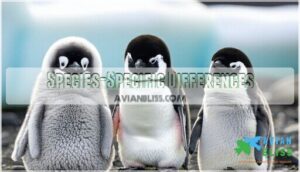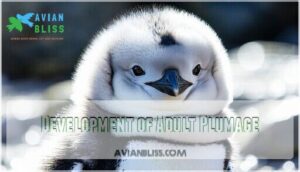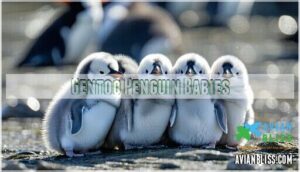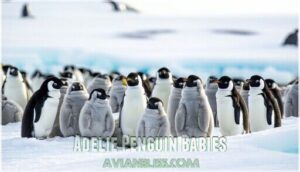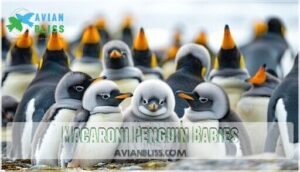This site is supported by our readers. We may earn a commission, at no cost to you, if you purchase through links.
 You’ll find baby penguins are nature’s ultimate bundle of fluff. These gray, downy chicks look like walking cotton balls with stubby wings and oversized feet.
You’ll find baby penguins are nature’s ultimate bundle of fluff. These gray, downy chicks look like walking cotton balls with stubby wings and oversized feet.
A baby penguin relies completely on its parents for warmth and food during its first months of life. Parents take turns keeping chicks cozy while the other hunts for fish.
These little ones huddle together in groups called crèches when both parents head out to sea. Their fuzzy down feathers keep them warm but aren’t waterproof yet.
They can’t swim until they grow their adult feathers. Understanding how these remarkable creatures survive harsh Antarctic conditions reveals fascinating survival strategies.
Table Of Contents
Key Takeaways
- You’ll recognize baby penguins by their fluffy gray down feathers – these chicks look like walking cotton balls and cannot swim until they develop waterproof adult feathers around 7-13 weeks old.
- Baby penguins do not eat solid food – instead, their parents feed them regurgitated fish, krill, and squid, with some species producing nutrient-rich "fish milk" for optimal growth.
- Penguin chicks form protective groups called crèches – when both parents hunt for food, these fluffy babies huddle together for warmth and safety while a few adults stand guard.
- Each penguin species has dramatically different baby sizes – Little penguin chicks weigh just 35 grams at hatching, while Emperor penguin babies can weigh up to 315 grams, showing incredible diversity across species.
Baby Penguin Terminology
You’ll learn the correct terms for baby penguins and their groups in this section. Understanding these names helps you talk about penguins with accuracy and confidence.
Collective Nouns for Penguins
When you’re watching penguins together, you’ll discover they’ve some of the most charming collective nouns in the animal kingdom.
These bird groups aren’t just called flocks like other species. Penguin communities have earned special names that reflect their unique collective behavior.
Here are the most common terms for penguin groups:
- Colony – The standard term for penguin society on land
- Raft – When they’re floating together in water
- Waddle – Describes their adorable walking formation
The word "crèche" specifically refers to baby penguin groups, borrowed from French meaning "crib." Crèche formation happens when chicks gather for warmth and protection. These noun origins capture the essence of penguin social life perfectly.
Species-Specific Names
While you might think baby penguins have cute species-specific nicknames, most penguin chicks share the same simple terms across all species.
You’ll find that whether it’s an Emperor or Little Penguin, their offspring are just called "chicks" or "nestlings."
However, some regional variations do exist. In Peru, locals call Humboldt penguins "pájaro-niño," meaning "baby bird." The Māori people refer to Yellow-eyed penguins as "hoiho," which means "noise shouter."
This naming confusion often surprises people who expect each species to have unique terms for their young. Despite different adult penguin names, a penguin fledgling remains universally adorable regardless of what you call it, and the terms "chicks" or "nestlings" are used universally, making the young of all species sound cute and simple.
Baby Penguin Appearance
You’ll notice baby penguins look completely different from their sleek parents with their fluffy down feathers that appear almost like fur.
These soft gray or brown coats keep the chicks warm but make them look more like fuzzy balls than the tuxedo-wearing adults they’ll become.
They will eventually grow into their tuxedo-wearing appearance, shedding their down feathers for sleeker plumage.
Down Feathers and Coloration
When you first spot a baby penguin, you’ll notice their soft, fluffy appearance comes from specialized down feathers. These downy insulation layers keep penguin chicks warm in harsh conditions.
The natal plumage varies dramatically across species, creating unique looks for each penguin offspring.
Here’s what makes their feather development so fascinating:
- Gray down dominates most penguin chick appearances
- Black helmet markings appear on Emperor penguin babies
- Brown coats develop on King penguin offspring
- White patches create contrast against darker areas
- Color changes occur as adult plumage emerges
This process of development is crucial for the young penguins as they grow and mature, eventually losing their baby feathers and gaining their adult look, which is a result of the feather development process and the unique looks of each species.
Species-Specific Differences
You’ll notice striking Down Variation across penguin species when comparing chicks.
Emperor penguin babies sport grey down with distinctive black helmet markings, while King penguin chicks develop fully brown coats.
The Size Disparity is remarkable – Little penguin chicks measure just 7 cm compared to Emperor chicks at 10 cm.
Each penguin species shows unique Growth Timeline patterns, with different Diet Diversity needs affecting their penguin development and distinctive penguin species characteristics during early penguin growth stages.
Development of Adult Plumage
Baby penguins undergo dramatic feather development as they mature.
You’ll witness down replacement happening gradually over several months. Their fluffy down feathers slowly give way to sleek adult feathers through feather molting.
This waterproofing development creates the iconic bird plumage we recognize. Juvenile appearance changes substantially during this process.
Plumage coloration shifts from drab greys and browns to the distinctive black-and-white patterns that make penguin feathers perfectly suited for aquatic life.
Baby Penguin Diet
You’ll find that baby penguins don’t eat solid food like adult birds do.
Instead, their parents feed them a special mix of regurgitated fish, krill, and squid that provides all the nutrients these growing chicks need to survive in harsh Antarctic conditions.
Regurgitated Food and Fish Milk
Penguin parents don’t whip up baby food from scratch. Instead, they rely on regurgitation to nourish their penguin chicks.
This digestion process creates a nutrient-rich mixture that varies by species variation. Some penguins produce "fish milk" through complete digestion, while others partially break down food.
This parental investment guarantees the best nutrient composition for rapid growth, with feeding frequency depending on the baby penguin’s developmental stage.
- Partially digested fish chunks floating in stomach acids
- Creamy, oil-rich "fish milk" resembling thick cream
- Krill fragments mixed with slimy digestive juices
- Squid pieces swimming in nutritious stomach fluids
- Regurgitated food creating a protein-packed smoothie consistency
Feeding Methods and Techniques
When you watch penguin parents feed their young, you’ll notice the regurgitation process looks like an awkward dance.
The penguin chick sticks its head deep inside the parent’s beak to access the nutritious meal.
Some species produce crop milk, a protein-rich substance similar to what pigeons create.
Feeding frequency varies by species, with some chicks eating up to 25 fish daily.
This krill vs. fish diet depends on local availability and seasonal changes.
Parental Care and Recognition
Parents don’t just drop off food and leave—penguin parenting involves serious commitment and recognition skills.
Each penguin chick has unique vocal calls that help parents identify their offspring among hundreds of others. This parent identification system guarantees proper care and feeding frequency.
Here’s how penguin parents master recognition and cooperative breeding:
- Voice matching – Parents memorize their chick’s specific call pattern
- Scent recognition – Adults use smell to confirm their penguin chick
- Visual cues – Size and markings help with identification
- Territory knowledge – Parents remember nesting locations
- Adoption behavior – Some adults care for orphaned chicks
This recognition system keeps families together during their precious time with parents.
Baby Penguin Hatching
You’ll witness penguin parents taking turns to keep their eggs warm for weeks or months before hatching begins.
Baby penguins break free from their shells weighing anywhere from 35 grams for little penguins to over 300 grams for emperor penguin chicks.
Breeding Strategies and Egg Laying
When these tuxedoed birds decide it’s time to start a family, they don’t mess around.
Most penguin species lay one to two penguin eggs per breeding cycle, though some lay just one precious egg.
You’ll find their nesting sites vary wildly – from rocky cliffs to ice shelves to underground burrows.
Mate selection often involves elaborate courtship rituals where partners exchange gifts like pebbles or perform synchronized dances.
| Species | Clutch Size | Nesting Location | Breeding Season | Mate Selection Method |
|---|---|---|---|---|
| Emperor | 1 egg | Ice shelf | Antarctic winter | Vocal displays |
| King | 1 egg | Rocky beaches | Year-round | Stone gifts |
| Adelie | 2 eggs | Stone nests | Antarctic summer | Pebble exchanges |
| Gentoo | 2 eggs | Grass/stone nests | Spring/summer | Nest building |
| Chinstrap | 2 eggs | Rocky cliffs | November-February | Trumpeting calls |
Parental roles split the egg incubation duties between partners, creating a perfect team for penguin incubation success.
Incubation Periods and Hatch Weights
Once eggs are laid, the real waiting game begins.
Penguin eggs require careful incubation that varies dramatically between species.
Emperor penguins endure the longest penguin incubation period at 64 days, while smaller species like Adelie penguins hatch after just 35 days.
Temperature plays a huge role in hatching time – warmer conditions speed things up by roughly 30-40 minutes per degree.
Egg composition directly affects hatch weight factors, with heavier eggs producing bigger chicks.
During bird incubation, parents take turns warming their precious cargo.
Parental roles become critical as proper temperature control determines chick survival rates.
This delicate egg incubation process sets the foundation for healthy penguin babies, where proper temperature control and healthy penguin babies are crucial, and the entire process relies on the precious cargo.
Baby Penguin Behavior
You’ll discover baby penguins have fascinating behaviors that help them survive in harsh environments.
These chicks form groups called crèches where they huddle together for warmth while their parents hunt for food.
Crèches and Collaborative Care
When penguin chicks reach two to three weeks old, they join crèches—nature’s version of penguin daycare.
These penguin nurseries form when parents head to sea for food.
Crèche formation provides chick protection from predators and harsh weather through thermal regulation.
You’ll find dozens of fluffy babies huddled together while a few adults stand guard.
This cooperative system guarantees reduced predation while parents hunt for their growing penguin chick.
Parental Care and Protection
Both adults share incubation duties, taking turns to keep their baby penguin warm while the other hunts.
You’ll find penguin care involves impressive chick recognition abilities—parents can identify their specific penguin chick among thousands using unique calls.
Feeding frequency reaches up to 25 fish daily during peak growth. Parents often seek the best penguin chick nourishment for their young.
For predator defense, colonies form protective huddles while alert adults watch for threats like skuas and seals.
Chick Development and Independence
Young chicks go through remarkable transformations as they prepare for life on their own.
Penguin chick development follows a predictable Growth Timeline that varies by species. Down feathers gradually give way to waterproof adult plumage through Molting Stages.
Here’s what you’ll witness during chick development:
- Feather Waterproofing develops between 7-13 weeks, enabling Independent Swimming
- Penguin feeding shifts from total dependence to self-sufficiency
- Post-Fledgling Survival depends on mastering hunting skills
- Penguin chick survival rates improve dramatically once waterproof feathers emerge
Baby Penguin Size
You’ll be amazed by the size differences among baby penguins when they hatch.
The tiniest fairy penguin chicks weigh just 35 grams while emperor penguin babies can weigh nearly 315 grams at birth.
Birth Weight and Growth Rates
Baby penguin hatch weight varies dramatically across species.
Little penguins start at just 35 grams while emperor penguin chicks weigh 315 grams at birth. This species comparison shows incredible diversity in penguin development.
Growth timeline differs too – Little penguins reach adult weight in 50 days, but emperor chicks need 150 days.
Most species take 55-100 days for full penguin growth, with weight gain supporting their penguin feeding needs, which is crucial for their development and survival, highlighting the importance of weight gain and diversity in penguin development.
Development of Water-Resistant Feathers
When do those fluffy penguin chicks trade their soft down for sleek adult feathers? The Down Transformation happens gradually as waterproof coat development begins around 7-13 weeks.
Oil Gland Function becomes essential during this process, helping create water-resistant plumage.
- Downy feathers provide initial warmth but aren’t waterproof
- Molting Stages occur in phases, replacing baby fluff with adult feathers
- Preening Importance increases as chicks learn grooming behaviors
- Insulation Changes from air-trapping down to streamlined waterproof protection
Swimming Ability and Independence
Once waterproof feathers develop, you’ll witness penguin chick independence unfold dramatically.
These youngsters can’t swim until their fluffy down transforms into sleek, ocean-ready plumage.
First swim marks a milestone in penguin chick development – they shift from land-bound babies to skilled ocean explorers.
| Milestone | Timeline |
|---|---|
| Waterproof Development | 7-13 weeks after hatching |
| First Swim | Once adult feathers appear |
| Independent Hunting | 2-4 weeks after swimming begins |
| Ocean Exploration | Full independence within months |
Predator avoidance becomes vital as penguin survival depends on these swimming skills.
Baby Penguin Species
You’ll find that each penguin species produces chicks with unique features and growth patterns.
Emperor penguin babies start nearly naked and develop gray down with black head markings, while King penguin chicks grow thick brown coats that make them look like fluffy teddy bears, with unique features and growth patterns.
Emperor Penguin Babies
Emperor Penguins create the ultimate baby penguin success story in Antarctica’s harshest conditions.
These fluffy Antarctic warriors prove that the tiniest penguins can conquer the world’s most brutal conditions.
These penguin chicks start life nearly naked before developing their signature grey down and black helmet markings.
Here’s what makes Emperor Penguin babies remarkable:
- Crop milk nutrition – Males produce nutrient-rich fluid for their chicks
- Antarctic adaptation – Survive temperatures reaching -40°F through huddling
- Crèche survival – Form protective groups at 45 days old
- Penguin development – Take 150 days to reach adult weight and independence
King Penguin Babies
King penguins produce some of the most dramatic baby penguin transformations you’ll witness.
These penguin chicks start nearly naked but develop thick natal down that resembles a fuzzy brown coat.
Their crèche formation begins around 40 days old, while molting timeline extends to 10 months.
Parents feed them fish milk during rapid penguin development phases.
| Development Stage | Timeline |
|---|---|
| Crèche Formation | 40 days old |
| First Molt | 10 months old |
| Adult Weight | 9+ months |
Gentoo Penguin Babies
Several Gentoo penguin chicks gather together in their penguin nursery around 20 to 37 days old.
These young penguins depend on parental recognition for survival during their early growth stages.
- Baby penguin nestlings huddle close for warmth and protection
- Penguin chick social behavior includes playing and learning together
- Parents carefully identify their own nestlings among hundreds in the colony
The Gentoo chicks diet consists of regurgitated fish, ensuring healthy development and impressive Gentoo fledging success rates.
Adelie Penguin Babies
Adelie penguin chicks gather in crèches when they’re just 16 to 19 days old, making them early socializers in the penguin colony.
These nestlings start with pale grey natal down that’s darker on their heads. Their juvenile plumage develops sooty brown second down, helping with Antarctic survival.
Parental recognition and predator avoidance skills develop quickly in these resilient penguin eggs-turned-chicks.
Macaroni Penguin Babies
You’ll be amazed by macaroni penguin chicks and their incredible journey.
These penguin breeding superstars create the world’s most abundant penguin species with nearly 24 million individuals. Baby penguin development in macaroni penguins shows remarkable parental recognition skills despite their vulnerable conservation status.
Here’s what makes macaroni penguin chicks special:
- Distinctive Crests: Adult macaroni penguins sport bright orange-yellow feather crests above their eyes
- Small Crèches: Penguin chick groups contain just five members unlike other species
- Grey Down Feathers: Baby penguin bodies are covered in grey down on upper parts
- Juvenile Molting: Young penguins shed their fluffy down for waterproof adult feathers
- Habitat Vulnerability: Human settlement threatens their breeding colonies across sub-Antarctic islands
Penguin development in this species faces conservation challenges requiring protection efforts.
Baby Penguin Care
You’ll discover that penguin chicks face harsh weather conditions and dangerous predators while growing up in some of Earth’s most extreme environments.
Understanding how baby penguins survive freezing temperatures and avoid threats helps explain why these remarkable birds have such strong family bonds and protective behaviors.
Environmental Factors and Predators
While baby penguins steal hearts with their fluffy appearance, they face serious penguin threats in the wild.
Climate change disrupts their penguin habitat by altering sea ice patterns and food sources. Giant petrels hunt vulnerable penguin chicks, while leopard seals lurk in coastal waters.
Invasive species like rats destroy eggs before they hatch. Marine pollution creates additional dangers through plastic ingestion.
You’ll find penguin parents using impressive predator defense strategies. They form protective huddles and use loud calls to ward off skuas and gulls.
Some species create underground burrows for safety. Penguin conservation efforts focus on protecting nesting sites from habitat loss and human disturbance.
These environmental pressures make survival challenging for even the most adorable penguin chicks. Parents may also invest in specialized penguin protection to keep their chicks safe.
Survival Statistics and Growth Rates
You might think baby penguin survival rates paint a grim picture, but these remarkable birds show incredible resilience.
Hatchling mortality varies dramatically by species – emperor penguin chicks face a staggering 90% mortality rate in their first year, while Adélie penguin chick mortality is much lower at 13.8%.
Weight milestones play a huge role in penguin survival. Chicks that reach higher weights early have better chances of making it through harsh conditions.
Growth factors like food availability and parental care directly impact these weight milestones. The molting impact on penguin growth can’t be ignored – chicks often lose weight during this energy-intensive process.
Independence age varies substantially, with some species reaching self-sufficiency at just 7 weeks while others need over a year of parental support.
Baby Penguin Development
You’ll watch baby penguins grow from helpless chicks into independent swimmers through an amazing process called molting.
During this time they lose their fluffy down feathers and grow waterproof adult feathers that let them swim and hunt on their own, which is a crucial step for them to become independent swimmers.
Molting Process and Feather Growth
When you’re watching penguin chick growth, molting timeline becomes fascinating.
Around ten months old, king penguin chicks shed their downy feathers for sleek adult plumage. This waterproofing development requires massive energy expenditure over six weeks.
The penguin fluff gradually disappears as waterproof feathers emerge. Post-molt survival depends on successful feather composition changes.
Bird development reaches a critical point when chicks trade warmth for swimming ability through this remarkable transformation.
Weight Gain and Nutrition
Young penguins pack on pounds at amazing rates during their first months.
Baby penguin chicks can gain up to 200 grams in just two weeks through frequent feeding sessions.
Penguin nutrition varies by species – some chicks eat 25 fish daily while others receive nutrient-rich regurgitated meals.
Specialized retailers offer penguin chick supplements for ideal growth.
Chick growth peaks around four months, then molting impact causes temporary weight loss as energy shifts toward developing waterproof feathers for swimming independence.
Independence and Self-Sufficiency
Independence marks a pivotal turning point in the penguin lifecycle.
Each penguin chick must master essential survival skills before leaving the colony.
They develop foraging skills by practicing diving techniques. Predator avoidance becomes second nature through constant vigilance.
Thermal regulation helps them survive harsh weather conditions. Social integration with other young penguins builds confidence.
Independent swimming signals readiness for penguin chick dispersal into the ocean, marking a key point in their thermal regulation and independent swimming abilities.
Baby Penguin Growth Stages
You’ll watch baby penguins go through three main growth stages as they develop from helpless chicks to independent adults.
These stages include the chick stage with fluffy down feathers, the fledgling stage when they can’t yet swim, and the juvenile stage when they grow their waterproof adult feathers.
Chick Stage and Down Feathers
You’ll notice baby penguin chicks start life looking nothing like their tuxedo-wearing parents.
These fluffy bundles sport thick down insulation that keeps them cozy in harsh conditions.
The chick molting process begins early, with feather development varying dramatically between species.
Here’s what makes penguin life cycle fascinating during this stage:
- Down feathers trap warm air like tiny sleeping bags
- Species variation means some hatch naked while others arrive fully fluffed
- Waterproofing timeline differs – some need weeks, others months
- Bird chicks can’t swim until proper feathers grow
- Penguin chicks rely completely on parents for warmth and food
The unique characteristics of penguin chicks, such as their thick down insulation and the fact that they can’t swim until proper feathers grow, highlight the importance of their development stage.
Penguin chicks are completely dependent on their parents, making the penguin life cycle a fascinating subject to study.
Fledgling Stage and Flight Development
Unlike typical bird chicks that develop flight abilities, penguin chicks enter their Fledgling Stage without ever taking to the skies.
During this critical Fledgling Timeline, baby fluff transforms as Feather Development accelerates.
These penguin chicks lose their downy coat while gaining waterproof feathers essential for Swimming Lessons.
Parents teach Independence Skills and Predator Avoidance techniques before chicks fledge into the ocean permanently.
| Development Stage | Key Changes |
|---|---|
| Early Fledgling | Baby fluff begins shedding |
| Feather Growth | Waterproof plumage emerges |
| Swimming Prep | Independence Skills develop |
| Ocean Ready | Predator Avoidance learned |
Juvenile Stage and Adult Plumage
After their first molt, baby penguin chicks transform into juveniles sporting sleek waterproof feathers.
This feather development marks serious business – they’re finally ready for their ocean debut. The plumage timeline varies by species, but waterproofing development happens fast once it starts.
Here’s what makes juvenile penguins special:
- Sleek new feathers replace fluffy down completely
- Waterproof coating develops for swimming readiness
- Adult coloring begins showing through juvenile patterns
- Independence readiness kicks in with new mobility
- Ocean preparation starts with waterproofing development complete
Frequently Asked Questions (FAQs)
Is pesto a baby penguin?
Yes, Pesto’s definitely a baby penguin! He’s a 9-month-old king penguin chick at Sea Life Melbourne Aquarium who became famous for weighing nearly 50 pounds—more than both his parents combined.
Is it legal to own a baby penguin?
You can’t legally own a penguin as a private individual.
They’re protected wildlife requiring special permits, massive care costs, and specific climates.
Zoos and research facilities need extensive licensing for penguin ownership.
Are baby penguins called puffins?
Baby penguins aren’t called puffins.
You’re thinking of two different birds.
Baby penguins are called chicks or nestlings, while puffins are separate seabirds with colorful beaks that also live in cold climates.
Where do baby penguins live?
These adorable fluffballs don’t just pick any old neighborhood.
You’ll find baby penguins in colonies across Antarctica, sub-Antarctic islands, and coastal regions of South America, Africa, Australia, and New Zealand where their parents nest.
What do baby penguins eat?
When you’re curious about penguin chick diets, they’re fed regurgitated fish, krill, and squid by their parents.
You’ll find adults store food in their stomachs, then deliver this nutritious mixture directly into their chick’s beak.
How big are baby penguins?
When they hatch, you’ll find penguin chicks ranging from tiny 3-inch Little Penguins weighing just 35 grams to hefty Emperor chicks at 4 inches and 315 grams—that’s quite the size difference!
What are baby penguins called?
You’ll hear penguin chicks called "chicks" or "nestlings" most often.
When they gather together in groups, they’re called a crèche – borrowed from the French word for crib, which perfectly captures their nursery-like gatherings, forming a nursery-like environment.
Is Pesto a baby penguin?
Yes, Pesto’s definitely a baby penguin! You’ll find this nine-month-old king penguin chick at Sea Life Melbourne Aquarium weighs nearly fifty pounds—that’s bigger than both his foster parents combined!
Is Pesto the penguin still a baby?
Pesto’s absolutely massive at 49 pounds, but he’s still technically a baby.
At nine months old, this king penguin chick hasn’t molted his fluffy brown down yet, which won’t happen until he’s ten months old.
What is a juvenile penguin?
A juvenile penguin is a young bird that’s outgrown its baby down feathers but hasn’t yet developed full adult plumage.
You’ll recognize them by their duller colors and smaller size compared to mature penguins.
Conclusion
From fluffy gray chicks to sleek swimmers, every baby penguin follows nature’s perfect blueprint for survival.
You’ve discovered how these remarkable birds depend on their parents, huddle in protective groups, and gradually develop the skills they need for ocean life.
Each species has unique adaptations that help young penguins thrive in harsh conditions, and next time you see these adorable creatures, you’ll appreciate the incredible journey from helpless chick to independent penguin ready to conquer Antarctic waters.
- https://www.pinterest.com/pin/736338607808769656/
- https://www.birdlife.org/list-penguin-species
- https://www.livescience.com/65339-emperor-penguin-chicks-drowning.html
- https://kids.nationalgeographic.com/animals/birds/facts/emperor-penguin
- https://www.antarctica.gov.au/about-antarctica/animals/penguins/emperor-penguin/breeding-cycle/


